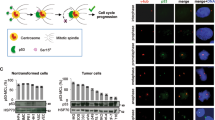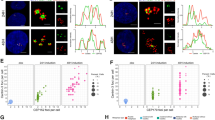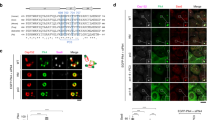Abstract
Abnormal centrosome numbers are detected in virtually all cancers. The molecular mechanisms that underlie centrosome amplification, however, are poorly characterized. Based on the model that each maternal centriole serves as a template for the formation of one and only one daughter centriole per cell division cycle, the prevailing view is that centriole overduplication arises from successive rounds of centriole reproduction. Here, we provide evidence that a single maternal centriole can concurrently generate multiple daughter centrioles. This mechanism was initially identified in cells treated with the peptide vinyl sulfone proteasome inhibitor Z-L3VS. We subsequently found that the formation of more than one daughter at maternal centrioles requires cyclin E/cyclin-dependent kinase 2 as well as Polo-like kinase 4 and that overexpression of these proteins mimics this phenotype in the absence of a proteasome inhibitor. Moreover, we show that the human papillomavirus type 16 E7 oncoprotein stimulates aberrant daughter centriole numbers in part through the formation of more than one daughter centriole at single maternal templates. These results help to explain how oncogenic stimuli can rapidly induce abnormal centriole numbers within a single cell-division cycle and provide insights into the regulation of centriole duplication.
This is a preview of subscription content, access via your institution
Access options
Subscribe to this journal
Receive 50 print issues and online access
$259.00 per year
only $5.18 per issue
Buy this article
- Purchase on Springer Link
- Instant access to full article PDF
Prices may be subject to local taxes which are calculated during checkout






Similar content being viewed by others
References
Anderson RG, Brenner RM . (1971). The formation of basal bodies (centrioles) in the Rhesus monkey oviduct. J Cell Biol 50: 10–34.
Bettencourt-Dias M, Rodrigues-Martins A, Carpenter L, Riparbelli M, Lehmann L, Gatt MK et al. (2005). SAK/PLK4 is required for centriole duplication and flagella development. Curr Biol 15: 2199–2207.
Bogyo M, McMaster JS, Gaczynska M, Tortorella D, Goldberg AL, Ploegh H . (1997). Covalent modification of the active site threonine of proteasomal beta subunits and the Escherichia coli homolog HslV by a new class of inhibitors. Proc Natl Acad Sci USA 94: 6629–6634.
Bornens M . (2002). Centrosome composition and microtubule anchoring mechanisms. Curr Opin Cell Biol 14: 25–34.
Brinkley BR . (2001). Managing the centrosome numbers game: from chaos to stability in cancer cell division. Trends Cell Biol 11: 8–21.
Dirksen ER . (1971). Centriole morphogenesis in developing ciliated epithelium of the mouse oviduct. J Cell Biol 51: 286–302.
Duensing S . (2005). A tentative classification of centrosome abnormalities in cancer. Cell Biol Int 29: 352–359.
Duensing S, Duensing A, Lee DC, Edwards KM, Piboonniyom S, Manuel E et al. (2004). Cyclin-dependent kinase inhibitor indirubin-3′-oxime selectively inhibits human papillomavirus type 16 E7-induced numerical centrosome anomalies. Oncogene 23: 8206–8215.
Duensing S, Lee LY, Duensing A, Basile J, Piboonniyom S, Gonzalez S et al. (2000). The human papillomavirus type 16 E6 and E7 oncoproteins cooperate to induce mitotic defects and genomic instability by uncoupling centrosome duplication from the cell division cycle. Proc Natl Acad Sci USA 97: 10002–10007.
Duensing A, Liu Y, Spardy N, Bartoli K, Tseng M, Kwon JA et al. (2006a). RNA polymerase II transcription is required for human papillomavirus type 16 E7- and hydroxyurea-induced centriole overduplication. Oncogene 26: 215–223.
Duensing A, Liu Y, Tseng M, Malumbres M, Barbacid M, Duensing S . (2006b). Cyclin-dependent kinase 2 is dispensable for normal centrosome duplication but required for oncogene-induced centrosome overduplication. Oncogene 25: 2943–2949.
Elbashir SM, Harborth J, Lendeckel W, Yalcin A, Weber K, Tuschl T . (2001). Duplexes of 21-nucleotide RNAs mediate RNA interference in cultured mammalian cells. Nature 411: 494–498.
Fabunmi RP, Wigley WC, Thomas PJ, DeMartino GN . (2000). Activity and regulation of the centrosome-associated proteasome. J Biol Chem 275: 409–413.
Freed E, Lacey KR, Huie P, Lyapina SA, Deshaies RJ, Stearns T et al. (1999). Components of an SCF ubiquitin ligase localize to the centrosome and regulate the centrosome duplication cycle. Genes Dev 13: 2242–2257.
Gstaiger M, Marti A, Krek W . (1999). Association of human SCF Skp2 subunit p19 Skp1 with interphase centrosomes and mitotic spindle poles. Exp Cell Res 247: 554–562.
Guarguaglini G, Duncan PI, Stierhof YD, Holmstrom T, Duensing S, Nigg EA . (2005). The forkhead-associated domain protein Cep170 interacts with Polo-like kinase 1 and serves as a marker for mature centrioles. Mol Biol Cell 16: 1095–1107.
Habedanck R, Stierhof YD, Wilkinson CJ, Nigg EA . (2005). The Polo kinase Plk4 functions in centriole duplication. Nat Cell Biol 7: 1140–1146.
Hagiwara H, Ohwada N, Takata K . (2004). Cell biology of normal and abnormal ciliogenesis in the ciliated epithelium. Int Rev Cytol 234: 101–141.
Hinchcliffe EH, Li C, Thompson EA, Maller JL, Sluder G . (1999). Requirement of Cdk2-cyclin E activity for repeated centrosome reproduction in Xenopus egg extracts. Science 283: 851–854.
Lacey KR, Jackson PK, Stearns T . (1999). Cyclin-dependent kinase control of centrosome duplication. Proc Natl Acad Sci USA 96: 2817–2822.
Lingle WL, Lutz WH, Ingle JN, Maihle NJ, Salisbury JL . (1998). Centrosome hypertrophy in human breast tumors: implications for genomic stability and cell polarity. Proc Natl Acad Sci USA 95: 2950–2955.
Martin LG, Demers GW, Galloway DA . (1998). Disruption of the G1/S transition in human papillomavirus type 16 E7- expressing human cells is associated with altered regulation of cyclin E. J Virol 72: 975–985.
Matsumoto Y, Hayashi K, Nishida E . (1999). Cyclin-dependent kinase 2 (Cdk2) is required for centrosome duplication in mammalian cells. Curr Biol 9: 429–432.
McIntyre MC, Ruesch MN, Laimins LA . (1996). Human papillomavirus E7 oncoproteins bind a single form of cyclin E in a complex with cdk2 and p107. Virology 215: 73–82.
Meraldi P, Lukas J, Fry AM, Bartek J, Nigg EA . (1999). Centrosome duplication in mammalian somatic cells requires E2F and Cdk2-cyclin A. Nat Cell Biol 1: 88–93.
Munger K, Basile JR, Duensing S, Eichten A, Gonzalez SL, Grace M et al. (2001). Biological activities and molecular targets of the human papillomavirus E7 oncoprotein. Oncogene 20: 7888–7898.
Nakayama K, Nagahama H, Minamishima YA, Matsumoto M, Nakamichi I, Kitagawa K et al. (2000). Targeted disruption of Skp2 results in accumulation of cyclin E and p27(Kip1), polyploidy and centrosome overduplication. EMBO J 19: 2069–2081.
Nigg EA . (2002). Centrosome aberrations: cause or consequence of cancer progression? Nat Rev Cancer 2: 1–11.
Nigg EA (ed). (2004). Centrosomes in Development and Disease. Wiley-VCH: Weinheim, Germany.
Pihan GA, Purohit A, Wallace J, Knecht H, Woda B, Quesenberry P et al. (1998). Centrosome defects and genetic instability in malignant tumors. Cancer Res 58: 3974–3985.
Salisbury JL, Whitehead CM, Lingle WL, Barrett SL . (1999). Centrosomes and cancer. Biol Cell 91: 451–460.
Sluder G . (2004). Centrosome duplication and its regulation in the higher animal cell. In: Nigg EA (ed). Centrosomes in Development and Disease. Wiley-VCH: Weinheim, Germany, pp 167–189.
Tsou MF, Stearns T . (2006a). Controlling centrosome number: licenses and blocks. Curr Opin Cell Biol 18: 74–78.
Tsou MF, Stearns T . (2006b). Mechanism limiting centrosome duplication to once per cell cycle. Nature 442: 947–951.
Vidwans SJ, Wong ML, O'Farrell PH . (2003). Anomalous centriole configurations are detected in Drosophila wing disc cells upon cdk1 inactivation. J. Cell Sci 116: 137–143.
Wigley WC, Fabunmi RP, Lee MG, Marino CR, Muallem S, DeMartino GN et al. (1999). Dynamic association of proteasomal machinery with the centrosome. J Cell Biol 145: 481–490.
Wojcik EJ, Glover DM, Hays TS . (2000). The SCF ubiquitin ligase protein slimb regulates centrosome duplication in Drosophila. Curr Biol 10: 1131–1134.
Acknowledgements
We thank Michel Bornens, William R Brinkley, Philip W Hinds, Karl Münger, Jeffrey L Salisbury and Jens Westendorf for sharing important reagents and/or helpful suggestions. We are grateful to Joseph Suhan for invaluable help and support with electron microscopy. We thank Huib Ovaa for helpful discussions. This work was supported by NIH/NCI grant R01 CA112598, the Susan G Komen Breast Cancer Foundation and a Research Scholar Grant from the American Cancer Society (to SD).
Author information
Authors and Affiliations
Corresponding author
Additional information
Supplementary Information accompanies the paper on the Oncogene website (http://www.nature.com/onc).
Supplementary information
Rights and permissions
About this article
Cite this article
Duensing, A., Liu, Y., Perdreau, S. et al. Centriole overduplication through the concurrent formation of multiple daughter centrioles at single maternal templates. Oncogene 26, 6280–6288 (2007). https://doi.org/10.1038/sj.onc.1210456
Received:
Revised:
Accepted:
Published:
Issue Date:
DOI: https://doi.org/10.1038/sj.onc.1210456
Keywords
This article is cited by
-
Aggresome assembly at the centrosome is driven by CP110–CEP97–CEP290 and centriolar satellites
Nature Cell Biology (2022)
-
MPS1 is involved in the HPV16-E7-mediated centrosomes amplification
Cell Division (2021)
-
Centrosome amplification: a quantifiable cancer cell trait with prognostic value in solid malignancies
Cancer and Metastasis Reviews (2021)
-
Cullin 5 is a novel candidate tumor suppressor in renal cell carcinoma involved in the maintenance of genome stability
Oncogenesis (2019)
-
Centrosome amplification, chromosomal instability and cancer: mechanistic, clinical and therapeutic issues
Chromosome Research (2016)



